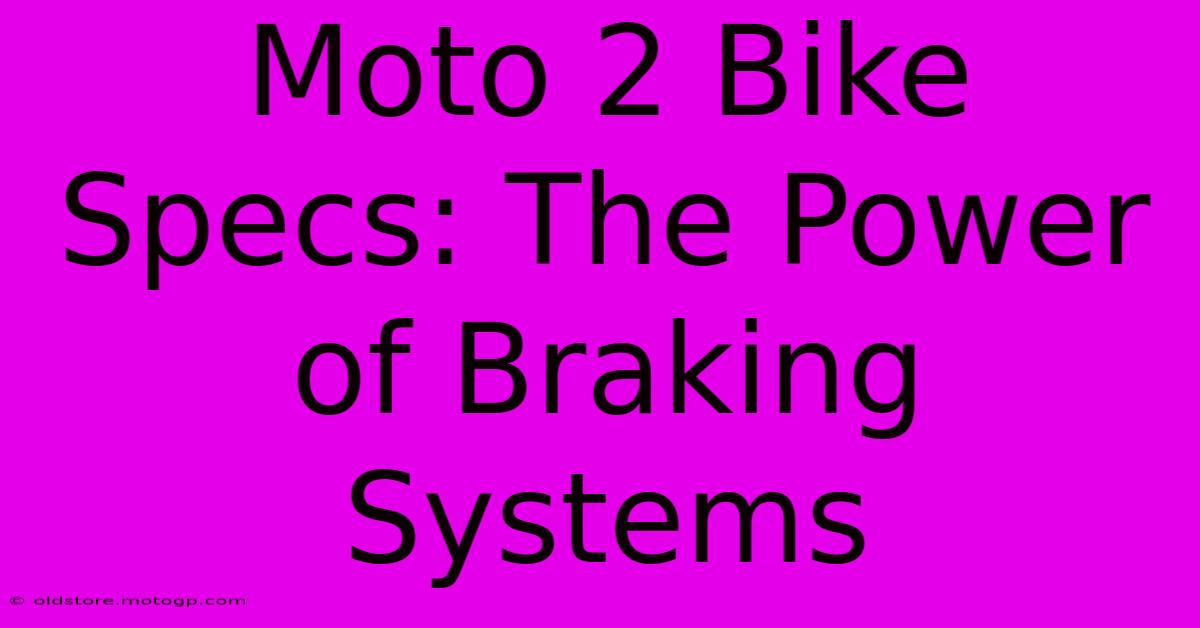Moto 2 Bike Specs: The Power Of Braking Systems

Table of Contents
Moto2 Bike Specs: The Power of Braking Systems
Moto2 racing is a thrilling spectacle of speed, skill, and precision. While horsepower and engine performance often steal the spotlight, the braking systems play a critical role in rider safety and lap times. Understanding the intricacies of these systems is key to appreciating the high-stakes world of Moto2. This article delves into the specifications and technology behind the powerful braking systems found on these incredible machines.
The Importance of Braking in Moto2
In the intense world of Moto2, braking isn't just about slowing down; it's about precise control, maximum deceleration, and rider confidence. The speeds involved demand exceptional stopping power and the ability to modulate braking smoothly and consistently, even under immense pressure. A fraction of a second's hesitation can mean the difference between a clean corner and a catastrophic crash.
Factors Affecting Braking Performance
Several key factors contribute to the effectiveness of a Moto2 braking system:
-
Caliper Design and Material: Moto2 bikes typically utilize high-performance calipers, often made from lightweight yet incredibly strong materials like forged aluminum or carbon fiber. These calipers house multiple pistons to squeeze the brake pads against the rotors with immense force.
-
Brake Pads: The composition of brake pads is crucial. Moto2 teams meticulously select compounds to optimize braking performance across different track conditions and temperatures. The pads need to offer consistent friction, even under extreme heat generated during repeated braking.
-
Brake Rotors: These discs are typically made from steel or carbon fiber, offering a large surface area for the brake pads to grip. Carbon fiber rotors are significantly lighter, contributing to reduced unsprung weight and improved handling. The design and venting of the rotors are carefully engineered to dissipate heat effectively.
-
Brake Master Cylinder: This component translates the rider's lever input into hydraulic pressure, controlling the force applied to the calipers. Precise adjustment and feel are paramount for rider control.
-
Hydraulic Lines: High-performance braided steel lines are commonly used to prevent expansion under pressure, ensuring consistent brake feel. This is crucial for maintaining control, especially during heavy braking.
Moto2 Brake System Specifications: A Deeper Dive
While precise specifications vary slightly between manufacturers and teams, here are some key features typically found in Moto2 braking systems:
-
Front Brakes: Typically utilize dual radial-mounted calipers gripping large diameter discs. The radial mounting provides enhanced stiffness and improved braking feel.
-
Rear Brakes: A single caliper and disc are usually employed at the rear, primarily for stability during braking and cornering.
-
ABS (Anti-lock Braking System): Although not mandatory, the use of advanced ABS systems is becoming increasingly common in Moto2 to enhance rider safety and prevent lock-ups. This system monitors wheel speed and adjusts brake pressure to maintain traction during hard braking.
-
Material Technology: The relentless pursuit of performance leads to the use of advanced materials such as carbon fiber for rotors and components to reduce weight and enhance braking efficiency.
The Human Factor: Rider Skill and Braking Technique
While the technology is crucial, the skill of the rider is the ultimate determinant of braking performance. Moto2 riders undergo rigorous training to master techniques such as:
-
Trail Braking: Applying brakes while simultaneously turning into a corner. This requires exceptional precision and coordination.
-
Engine Braking: Utilizing the engine's resistance to decelerate the motorcycle, working in conjunction with the brakes.
-
Smoothness and Consistency: Maintaining a smooth and consistent application of brake pressure is vital for optimal control and lap times.
Conclusion: Braking - An Unsung Hero of Moto2
The braking systems in Moto2 bikes are far more than just components; they are sophisticated technological marvels, integral to the safety and success of the riders. The complex interplay of engineering, material science, and rider skill makes the braking system a crucial element, often overlooked in the excitement of high-speed racing. Understanding these systems enhances appreciation for the incredible precision and performance that characterizes Moto2 racing.

Thank you for visiting our website wich cover about Moto 2 Bike Specs: The Power Of Braking Systems. We hope the information provided has been useful to you. Feel free to contact us if you have any questions or need further assistance. See you next time and dont miss to bookmark.
Featured Posts
-
Lub Si Cota Living A Life You Love
Feb 20, 2025
-
Moto2 Standings The Road To The Championship
Feb 20, 2025
-
Circuit Race Vs Other Motorsports Whats The Difference
Feb 20, 2025
-
Austins Dynamic Sprint Race
Feb 20, 2025
-
Cota One Day Pass Budget Friendly Columbus Exploration
Feb 20, 2025
